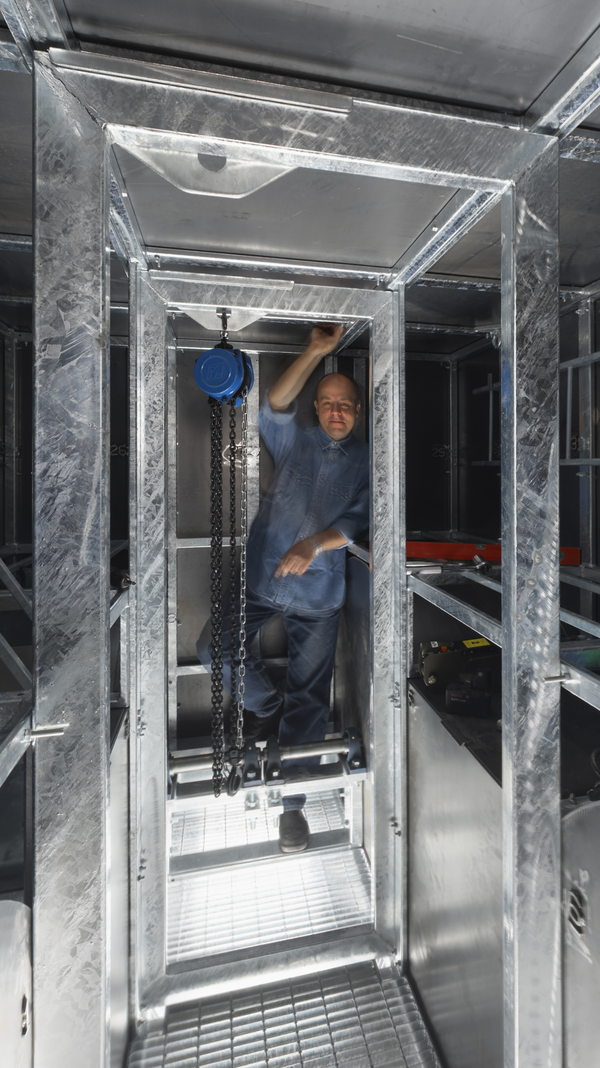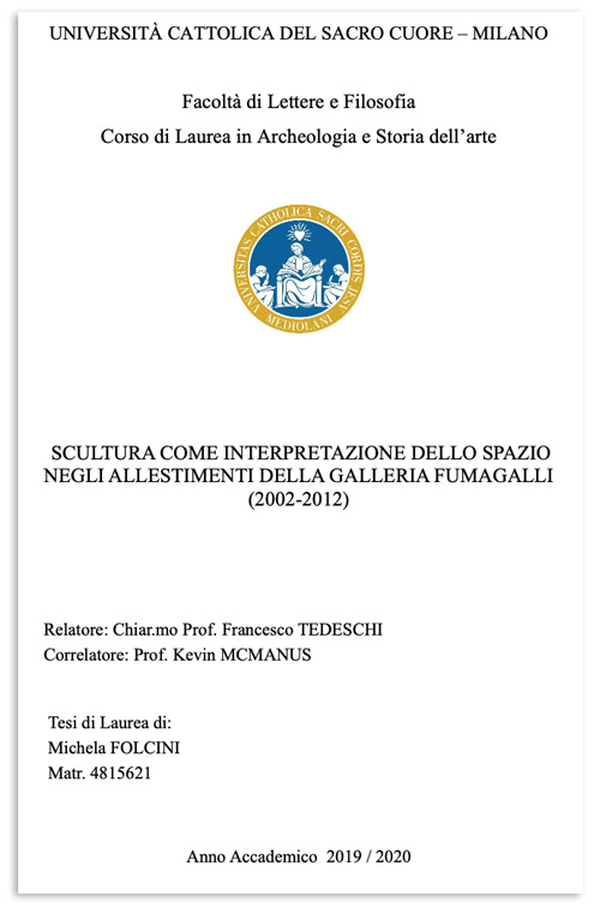Umberto Cavenago was born in Milan in the second half of the 20th century, in 2009 he moved to Switzerland where he now lives and works. His research blends his passion for the culture of art and the culture of project; his interventions, always related to both architectural and natural space, establish a formal and destabilizing dialogue in an anti-celebratory and never definitive relationship. He works with a wide variety of materials. The construction methods adopted by Umberto Cavenago do not come from artistic practice, but from the industrial world: feasibility study, design, choice of materials, estimate, implementation. A system of approach that Cavenago seems to have in common with the industrial designer, but which contains a pitfall: he does not design a prototype for mass production, nor does he put it into the production cycle.
He uses this approach to achieve a heresy: the unique piece, that “original” work of art that denies – by virtue of its non-replicability – any possible link with the culture of the project.
Umberto Cavenago transforms the wheel from a motor prosthesis into a tool for the modification and perception of three-dimensional art, creating a consolidated but “transportable” space, a feature that puts into crisis the cornerstone of the artistic practice, which wants the observer in contemplation of a work conceived in a static way.
Many works appear as simplifications of "original" objects in a minimal key, but completely devoid of any mechanics and thus reduced to their semantic limit of function: a sort of metaphysical reverberation of serially produced objects.
In addition to the relationship between its interior space and the observer, there is a relationship between the object and the environment in which it is placed. The architectural space is the subject of a careful and systematic investigation. Many of the works are conceived as measuring elements of space and at the same time they destabilizing it.
The monograph of Umberto Cavenago published by Silvana Editoriale

Umberto Cavenago portrayed by Alezzandro Zambianchi in 2006 inside his work La 74
Photo © Alessandro Zambianchi, Milano
Among the many exhibitions:
the XLIV Venice Biennale in 1990, where he exhibited three large self-propelled frames on wheels, which, leaning against the walls, frame parts of the same exhibition space;
In the same year he took part in L’altra scultura at the Mathildenhöe in Darmstadt, at Palacio de La Virreina in Barcelona and at Centro de Arte Reina Sofia in Madrid.
In 1991 he presented a personal room in Metropolis at the Martin-Gropius Bau in Berlin; a few years after the fall of the Berlin Wall, a tour of six-metre-high columns with wheels and oriented east-west, underline the epochal change of the two "Germanies" that are reuniting.
In 1992 he exhibited at the exhibition Recent Italian Art at the Center of the Arts in Pittsburgh.
In 1993 he created for the exhibition In forma at Pecci Museum in Prato L'arte stanca, the mobile work that crosses the rooms diagonally cutting the spaces of the museum connecting their ends.
He took part in the Johannesburg Biennale in 1995 with Opera sinistra e opera destra.
In 1996 at Ultime Generazioni on the occasion of the XII Quadriennale d'Arte in Rome, he presented his first interactive digital work, La smaterializzazione dell'Arte.
Also in 1996, immediately after the exhibition Visioni at Galleria Nazionale d’Arte Moderna in Rome, he represented Italy at the 23rd International Biennale of San Paolo, participating with a personal room populated by computers that reproduce interactive images of Italian urban scenes characterized by opulent monuments: the interaction with the public includes the possibility of "eliminating" monuments virtually, clearing the squares of celebratory rhetoric.
In 1997 the work Nastro trasportatore, an electromechanical sculpture in three modules, crossed the walls of Le Magasin, Centre National d'Art Contemporain in Grenoble for the exhibition “Des histoires en formes”.
In the same year he exhibited at the Melina Mercouri Pneumatiko Kentro Foundation in Athens, on the occasion of the exhibition Exlelixis.
In 2000 he created Gallery Crossing, a site specific project for IASKA in Kellerberrin, Western Australia.
In 2005 and 2011 he exhibited at the exhibitions “Scultura italiana del XX secolo” and “Scultura italiana del XXI secolo” at Fondazione Arnaldo Pomodoro in Milan.
In 2006 for “Sculture in villa”, at Villa d'Este, Tivoli he designed La 74, a tribute to the novel by Filippo Tommaso Marinetti "L'alcòva d'acciaio".
In 2007 the same work was "parked" in Padua in Piazza Insurrezione,
in 2009 at Castello Visconteo in Jerago (Varese),
in 2013 at Reggia di Venaria Reale,
in 2015 at Ex Albergo di virtù (NH Collection in Piazza Carlina) in Turin,
in 2020 on the churchyard of Sant'Agostino in Pietrasanta,
in 2021 in front of the Town Hall of Caldaro,
in 2022 inside the Horti Leonini in San Quirico d’Orcia.
In 2011 he participated in the exhibition Il Futuro nelle mani, artieri domani, at the Officine Grandi Riparazioni in Turin for Esperienza Italia150°.
In 2012 he exhibited at Cantiere del ‘900. Opere dalle collezioni Intesa Sanpaolo, Gallerie d’Italia in Milan, a work in the permanent collection.
In 2018, in front of the Maroggia pier on Lake Lugano, he laid the floating sculpture Protecziun da la Patria, an interpretation of a naval mine, a harmless version of a device in use during the last world wars. The work was installed in 2019 in front of Villa Santa Lucia in Melano and in 2022 in Bissone.
In 2020 it is the turn of Centrifugo installed in Peccioli (Pisa). Almost a parallelepiped, empty inside, uneven in its shape and broken down longitudinally to be able to bend 30° inside a hairpin. A deconstructed volume on four large wheels, two of which, those inside the curve, are solid to the ground and the other two, the outer ones, almost lifted off the ground due to the inclination.
In 2021 the Sweet Home project is the winner of the public notice “PAC2020 - Plan for Contemporary Art” promoted by Direzione Generale Creatività Contemporanea of the Italian Ministry of Culture. Sweet Home is an additional exhibition space of the Suzzara Prize Gallery, an architecture "moored" on the golenal mainland of the Po river; the flooding of the river will create the conditions for the work to float. At the natural return of the flood, Sweet Home will rest on the ground, never in the same position and inclination.
There are many participations in private galleries with personal and collective exhibitions.
Umberto Cavenago was a contract lecturer at Accademia di Belle Arti of Bergamo from 1996 to 2010 and at Accademia di Belle Arti of Urbino from 2006 to 2012, experimenting with projects in the fields of Painting, Anatomy, Multimedia Design, Interactive Systems and Sculpture.
Since 2015 he has managed an independent exhibition space within his permanent installation L’alcòva d’acciaio di Umberto Cavenago, hidden in a forest of the Langhe.
Sculpture as an interpretation of space in the installations of Fumagalli Gallery (2002-2012)
Chapter IV, Umberto Cavenago
Degree Thesis by Michela Folcini
UNIVERSITÀ CATTOLICA DEL SACRO CUORE – MILAN
Faculty of Arts and Philosophy, Degree Course in Archaeology and History of Art
Relator Prof. Francesco Tedeschi
Assistant Supervisor Prof. Kevin McManus
Academic Year 2019 / 2020

Social
Contatti
umberto@cavenago.info